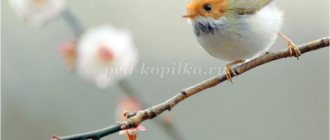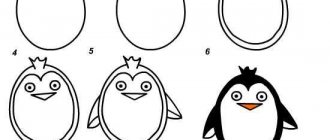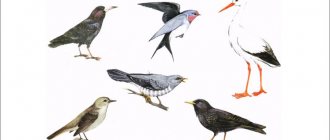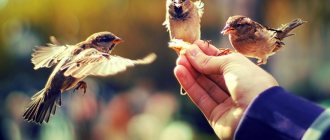Game - quiz in the senior group on the topic: Birds
Summary of the game - a quiz to familiarize children with the natural environment in the senior group on the topic: “Our feathered friends.”
Author: Melnikova L.V.
Goal : To consolidate children's knowledge about the birds of their native land; practice the ability to make descriptive riddles about birds; recognize birds by their voices on slides; practice quantitative counting within 10. Develop logical thinking and reaction speed. Practice the ability to coordinate your actions with the actions of the players on your team, and follow the rules of the quiz. Learn to behave correctly in nature so as not to harm it; to form an environmentally conscious attitude towards nature and its inhabitants, to cultivate interest and a caring attitude towards birds - our friends. Vocabulary work: birds, migratory, wintering, nest, birdhouse, chips, edge, area, slide, screen. Material: map of the Samara region; model of a tree, planar images of birds attached to it; tape recorder, audio recording with bird voices; audio recording of M. Glinka’s music “Lark”; screen, projector, selection of slides on a computer with images: magpie, peacock, stork, goldfinch, pelican, ostrich, nightingale, crossbill, swift, penguin; 2 sets of paper birdhouse parts, magnetic board, magnets; medals - gold and silver according to the number of players in the teams; magpie costume; chips; caps of birds (owl, tit, sparrow, swallow). Preliminary work: bird watching;
conversations about the life of birds; excursions to bird nesting sites; viewing a map of the Samara region; parents making feeders and birdhouses; participation in the campaigns “Feed the birds in winter”, “Meet the starlings”; learning poems, riddles, proverbs, sayings about birds; making attributes for the quiz; creating slides on the topic of the lesson; educational games about birds. Quiz progress:
Children sit in a semicircle.
Educator: Dear friends! Look, you and I live in an amazing, wonderful region (shows on the map). Tell me, what is the name of the region in which we live? Children: Samara region. Educator: Well done! Right. What do you think our region is rich in? Children: Forests, wildlife, rivers, lakes. Educator: Good guys! Yes, we have a very rich flora and fauna. There are many lakes, rivers, forests, meadows that need to be treated with care and concern. There are also many birds living in our region. Tell me, why do we call birds our friends? Children: Birds destroy harmful insects and caterpillars, preserving the foliage of trees and shrubs. They delight us with their wonderful singing. Educator: Why are birds called feathered? Children: Because their body is covered with feathers. Educator: Well done! They answered correctly. Today I invite you to take part in the game - quiz “Our Feathered Friends” and test how well you know the birds of your native land. Do you agree? Children: Yes. Educator: First, let's remember the rules that must be followed during the quiz. Children: - Listen to the question to the end. — Raise your hand, do not shout from your seat. - Don't interrupt your comrades. - Don't give me any hints. - You can complement the one who answers. — Count the chips at the end of the game. Educator: Please divide into two teams and come up with a name for them. The title should be related to the name of our quiz "Our Feathered Friends". Don't forget to choose team captains. Children are divided into teams and seated opposite each other. Then they introduce their teams and captains. Educator: Look, guys, birds living in the Samara region have flown to our tree. Each bird brought with it a competition task. One player from the team names the bird and removes it from the tree, and I read the task. For winning the competition, the team is awarded a chip. The team that collects the most chips wins. Begin. Nuthatch bird. Competition task "Guessers". Each team is asked to guess 3 riddles about birds. The winner is the team that solves all the riddles. -The blackest of all migratory birds, Clears the field of worms. (Rook) - Stands on one leg, screams at the whole swamp. (Heron) -Everything is spinning, fussing, She can’t sit still, It’s lively... (Tit). - All day long, the bitch screams peek-a-boo throughout the forest. (Cuckoo) - A diligent worker, a forest-nosed carpenter. (Woodpecker) - Loud trills arrived in the spring. (Nightingale) Seagull bird. Competition task “Name proverbs and sayings about birds.” Teams take turns naming proverbs and sayings. The team that names the most wins. -I saw a rook - welcome spring. -Rook, on the mountain - spring is in the yard. -A forest without birds and birds cannot live without a forest. -Birds are the decoration of the forest. -We will protect birds from destructive encounters. -Let's be friends with the birds and cherish this friendship! Owl bird. Competition task “Guess the bird by its voice.” Each team is asked to guess three birds by listening to an audio recording of their voices. The team that names all the birds correctly wins. Cuckoo bird. Poetic intermission. Children from each team read 2-3 poems about birds. Nightingale. The nightingale has flown in. It becomes more cheerful every hour, The trills flow endlessly... It’s a little offensive that the winged singer is not visible in the thickets. V. Musatov. I love birds. Guys, I love birds. I never catch them, neither with traps nor in nets. I don’t keep them in a cage at home. I will never touch the nest of a magpie or a crow, I have never offended a starling or a sparrow in my life. A. Ladonshchikov Sinitsa. You and this fashionista are familiar, of course: The pinwheel can’t sit still - He keeps bragging about his blue frock coat and his blue cap. The titmouse is proud. E. Ilyina. Bullfinch. He does not suffer from colds, is not afraid of evil blizzards, and in winter does not fly away to the distant, sultry south. Let the piles of snow cover both the hillock and the wasteland - The red-breasted beauties are glad The resident of the north is the bullfinch. E. Ilyina. Starling bird . Captains' competition "Make a birdhouse." The captains lay out birdhouses on a magnetic board made of ready-made paper parts. The winner is the one who quickly and accurately completes the task. Bullfinch bird. Competition task "Don't make a mistake." Each team is presented with images of 5 birds on the screen using a projector. We need to choose from them, the birds of the Samara region. The team that correctly names the birds of the Samara region wins. An approximate list of birds: -magpie, peacock, stork, bullfinch, pelican; -ostrich, nightingale, crossbill, swift, penguin. Physical exercise. Game “One, two, three show the bird.” To the music of M. Glinka “Lark”, children “fly” in all directions. The music stops, the children freeze, imitating the birds of our region. The presenter asks what bird the children are portraying. The game is repeated three times. Crow bird. Competition task “Name the signs associated with birds.” Teams take turns naming signs. The team that names the most wins. -Crows sit on the snow - to the thaw. -Crows sit on the tops of trees - to frost. -Swallows fly low in the rain. -Crows and jackdaws sit on low branches - towards the wind. -I saw a rook - welcome spring. Swallow bird. Competition task “How a person takes care of birds.” Players on each team list the actions of people that indicate their concern for the birds. The winner is the team that names the most actions. (They protect nests, prepare food for the winter, feed birds in winter, make and hang feeders and birdhouses). Jackdaw bird. Competition task “Explainers”. Two players per team go behind the screen, put on bird hats (owl, sparrow, tit, swallow) and ask descriptive riddles about these birds to the players of the other team. After the team has given the answer, the child comes out from behind the screen. The team that solves the riddles wins. Cuckoo bird. Competition task “Answer quickly.” Each team is asked to quickly answer 5 questions. The team that gives the correct answers wins. Questions for the first team: -what does the bird rule? (Tail); -What bird brings spring? (Rook); -What is the name of the baby bird? (Chick); -What is the name of the starling's house? (birdhouse); -What are the names of the birds that remain to spend the winter in our area? (wintering). Questions for the second team: -What are the names of birds that fly to warmer regions in the fall? (Migratory); -Which bird is called the forest doctor? (Woodpecker); -What is the name of the swallow's house? (Nest); -Which bird throws its eggs into other people's nests? (Cuckoo); -What is the bird’s body covered with? (Feathers). Educator : Look, guys, all the birds have flown away from our tree. Our quiz has come to an end. You coped with all the tasks perfectly, well done! You know a lot about the birds of our region. Let's count how many chips each team got. Children count the chips, at this moment a magpie flies in (prepared child). Magpie: I was flying past you guys and saw you. I'm very happy for you. You know a lot about us. I want to give you advice: Take care of nature from an early age! Where we nest, don’t make noise, Take care of our nests! Protect birds and animals and always help them! Guys, please remember the rules. Do not come close to bird nests, do not touch them, do not destroy them. Do not catch and take home chicks; in nature, birds take care of them. Educator: Thank you, white-sided magpie, for your useful advice. Who was our winner? The captain of each team announces the number of chips. The winner of the quiz is announced. Soroka: I congratulate the winning team and present them with gold medals. And the other team has silver ones, they also shine. Educator : Let's be friends with the birds and cherish this friendship!
We recommend watching:
Quiz for the preparatory group of kindergarten Quiz for preschoolers. Middle group Art quiz for children of the preparatory group Quiz on Pushkin's fairy tales for children of senior preschool age
Similar articles:
Literary quiz for older preschoolers “Visiting a fairy tale”
Game-quiz for children 5-7 years old “Journey to a Fairy Tale”
Riddles quiz for children for middle school children
Theater quiz for the senior group
Music quiz for preschoolers 4-6 years old
Quiz "Migratory birds"
DUCK STORK
ROOK HERON
Educator:
What do the names of these birds have in common?
(children's answers)
What birds are called migratory?
(children's answers)
How do migratory birds differ from wintering birds?
Why did migratory birds fly to warm countries? Why do they come back when spring comes? (children's answers)
Teacher:
We talked a lot about migratory birds. Today I invite you to check how you remember and understand the material on this topic. I invite you to take part in the quiz. For every correct one I will give out a token. Whoever ends up with the most tokens becomes the winner of our quiz.
Round
I Quiz Questions
- What migratory birds are you familiar with? (children's answers)
- What is the main reason for birds migrating to warmer regions with the arrival of autumn? (Only due to lack of food. Cold is not the reason for the flight. A hungry bird freezes, a well-fed one never.)
- People say: “This bird has a magical song and modest plumage” (nightingale)
- What do nightingales eat? (caterpillars, larvae, worms)
- Identify the bird by description: “Its back and sides are gray, its belly is white, the upper part of its breast, tail, and wings are black, shiny, decorated with white feathers at the edges” ( wagtail)
- People call this bird “icebreaker” (wagtail).
Explain why?
(the bird runs along the ice floes, looks for bugs frozen in the ice, shakes its tail.) - What bird's chick doesn't know its mother? (Cuckoo chick.)
- Who “raises” the little cuckoo chicks?
- What forest bird makes a nest on the ground? (Chiffchaff).
- Why did scientists exonerate the cuckoo, despite the fact that foundling cuckoos throw other chicks out of the nest? (The cuckoo is the only bird that eats furry (poisonous and most voracious, destroying forests by the hectares) caterpillars. No other bird touches these caterpillars.)
- What birds come to us first in the spring? (Rooks.)
- Why do rooks “discover” spring, and swallows arrive later than other birds? (Due to the way they feed. Rooks look for food in the soil, and swallows catch insects in flight. Insects appear in the air later, and accordingly, swallows arrive later than other birds.)
- What does a rook eat? ( insects, worms, field mice, snails, (can catch a young hare).
- Who rests while sitting on wires? If it flies low to the ground, it means rain. (Martin.)
- Who is the swallow's enemy? ( sparrow. It often attacks and captures swallows’ nests, throwing out tiny chicks from there)
- Which bird of our forests best imitates bird voices? (Starling.)
- Which bird is a symbol of beauty, purity and tenderness? (Swan.)
- What birds catch insects in flight? (Swallows)
- Where do starlings nest? (in hollows, in birdhouses)
- In which calendar periods does the starling have shiny black plumage with a greenish tint, and in which periods is it speckled (with white spots), with a characteristic
metallic shine? ( black - in spring and summer, speckled - in autumn and winter)
- A person who studies birds and their habits is... ( Ornithologist)
- Which bird lays its eggs in the nests of other birds?
- "Finish the sentence"
— the sparrow is small, and the crane…….
- the crow is big, and the tit.....
- The tit has a short tail, and the wagtail...
- The woodpecker has a long beak, and the bullfinch.....
- the duck is gray, and the swan......
2
“Guess the bird by its singing.”
Educator:
Each bird has its own special singing, different from other birds.
Try now to dryly determine which bird is singing. (I turn on a recording with the voices of birds. Children must identify the bird by its singing and name it)
III
round “Rebuses”.
Summing up: the winner receives a reward, all participants receive a sweet prize.
Outdoor game “Turn into a bird”
Leading:
“One, two, three, turn around and turn into a bird” (children imitate the gait, habits and voices of sparrows into a sparrow, then into a crane, swallow)
Summarizing.




